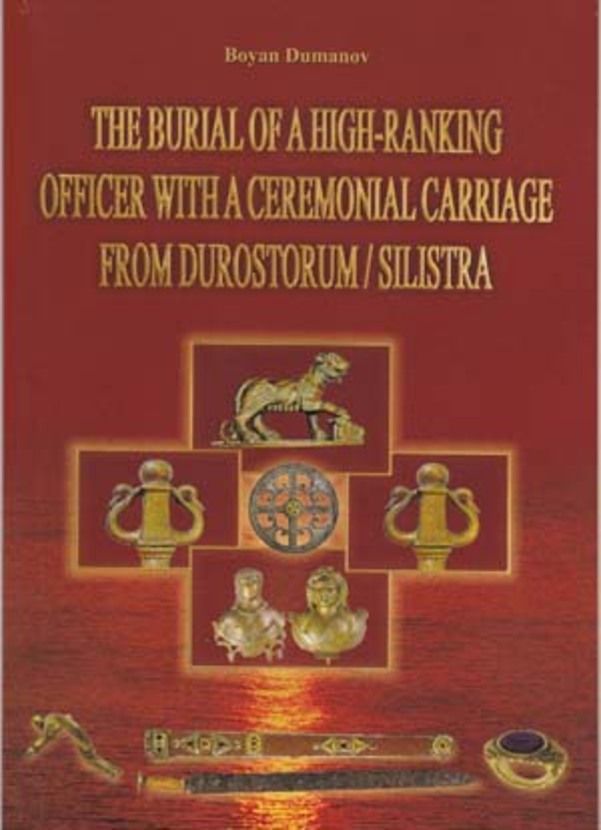
The burial of a high-ranking officer with a ceremonial carriage from Durostorum / Silistra
Изследвания
Описание
Predominantly, the carriage finds as parts of burial complexes discovered on the Balkans, originate from the region to the south of Haemus or the territory of the Roman province of Thrace. Currently, north of Haemus, two-wheeled and four-wheeled carriages have been found only in the vicinity of the village of Telets, in the region of Razgrad, and the Durostorum grave. At the same time, however, this custom does not pertain just to the Balkans, but has also been documented in Pannonia.
Consequently, in the context of the Roman provincial culture, this does not constitute a unique Thracian phenomenon but is rather a manifestation of elitism. The grave finds, as well as the structure of the carriage itself, indicate this to be the latest occurrence of such custom on the Balkan Peninsula in a period when the custom of burying carriages in or in the vicinity of the grave had long been abandoned south of Haemus.
The custom of depositing weapons in the burial facility, especially in such numbers, is also not among the typical characteristics of the burial ritual in the course of the Roman imperial period. The rare finds of swords in graves mainly originate from tumuli or single graves in complexes south of Haemus. Apart from the Durostorum swords, the only similar find in Moesia of a sword excavated from a grave with a dead body is from the village of Snezhina, region of Varna. These circumstances enable us to assume that the officer buried with the carriage, weapons and military insignia can’t have been born in the Roman provinces, but must have been of a barbarian origin, holding high-ranking positions in the military hierarchy. This is further confirmed by the fact that the social status symbols themselves (ornamenta dignitatis) were also placed in the grave, a practice which was not common among the representatives of the population holding the status of a Roman citizen, who therefore identified themselves as Romans. Between the 3rd century and the beginning of the 4th, such situations are familiar from areas beyond the Roman provinces and mostly in Germanic burials beyond the Rhine and the Upper Danube. The warrior affiliations of the Germanic individuals who served in the Roman army is demonstrated by placing silver spurs in the graves, while the golden or silver brooche along with the folded cloak are placed at the feet of the deceased. On the other hand, however, similar insignia, known from the territory of the Roman provinces, mostly the Balkans, became known due to their being deposited as hoards, since they were considered to be family heirloom, not just forms of personal prestige.
The precise ethnic background of the Durostorum officer is hard to determine. Having in mind that he achieved the highest point in his career in Gaul, Raetia, Noricum or Pannonia, his origin could be associated with the Germanic people involved in the defense of those provinces. The richly decorated with inlays sword, on the other hand, has counterparts mainly among artifacts from the Sarmatian or North Black Sea region. During the second half of the 3rd and the 4th century, Sarmatians inhabited the area immediately to the east of Pannonia, between the Middle Danube and the Tisza River, and this ethnic group was traditionally recruited to serve in the auxiliary troops for the Roman legions, especially in the western provinces.
How that officer ended up in Durostorum could be explained by the fact that he might have been stationed in the city upon his retirement or redeployed in the Lower Danube area. Between the late 3rd century and the early 4th century, the price of a carriage is estimated to have been between 7,000 and 10,000 denarii. For the average Roman citizen that must have been a comparatively large of amount of money, moreover, having in mind that at the time, the annual salary of a legionary could reach 7,500 denarii. The buried officer did not hold an ordinary military rank, and most likely belonged to the elite cavalry (equites promote), whose salary could reach 54,000 denarii per year. The wealth of the grave find, as well as its location in the still functioning necropolis of the city, indicates that this must have been a renowned member of the local elite. The luxury vehicle buried with him attests to his high financial status and active involvement in the social life of this important Roman city on the Danube.
